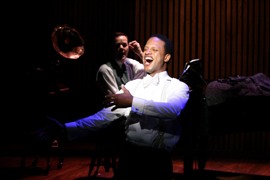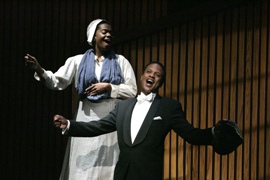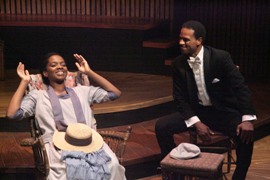
Before there was Paul Robeson, before there was Marian Anderson, a young man ten years their junior became the first African-American to achieve worldwide acclaim on the concert stages of the United States and Europe.
It is this lesser-known music—and civil rights—pioneer that playwright Daniel Beaty brings to vibrant, compelling life in his “play with music” Breath And Imagination: The Story Of Roland Hayes, now being given a pitch-perfect West Coast Premiere at Burbank’s Colony Theatre under the inspired direction of Saundra McClain.
 We first meet Hayes (Elijah Rock) at the peak of his success in 1942, as the then 55-year-old—who had already sung on the stages of Boston’s Symphony Hall, the Hollywood Bowl, and Buckingham Palace—announces to assembled students his decision not to open the music school they have come to attend, a school in which both blacks and whites were to be studying together inside the very Georgia plantation where Roland Hayes’ mother had once been a slave.
We first meet Hayes (Elijah Rock) at the peak of his success in 1942, as the then 55-year-old—who had already sung on the stages of Boston’s Symphony Hall, the Hollywood Bowl, and Buckingham Palace—announces to assembled students his decision not to open the music school they have come to attend, a school in which both blacks and whites were to be studying together inside the very Georgia plantation where Roland Hayes’ mother had once been a slave.
The recent arrest of Hayes’ wife Alzada and their daughter Afrika for sitting in the whites-only section of a Rome, Georgia shoe store—after which Hayes himself was arrested and beaten—has convinced the celebrated tenor that the time is not yet right for his vision of racial harmony to come to fruition.
 A series of flashbacks then transport us to Roland’s childhood in rural Tennessee, where the eight-year-old’s angelic voice would seem likely to take him, not to the world’s major concert stages, but to the preacher’s pulpit, a future his mother Angel Mo’ (Karan Kendrick) sees as her child’s God-given destiny.
A series of flashbacks then transport us to Roland’s childhood in rural Tennessee, where the eight-year-old’s angelic voice would seem likely to take him, not to the world’s major concert stages, but to the preacher’s pulpit, a future his mother Angel Mo’ (Karan Kendrick) sees as her child’s God-given destiny.
Then one day young Roland happens to hear a recording of reigning operatic superstar Enrico Caruso and the vocally gifted child begins to dream of a future in music, a dream fueled by local music teacher Mr. Calhoun (one of eight roles brought to life by Kevin Ashworth), who accepts Roland’s father’s pocket watch as payment for a series of lessons that will lead to the young singer’s acceptance—and full scholarship—at Fish College, where he becomes vocal soloist for the school’s Jubilee Singers.
Over the course of Breath And Imagination’s intermissionless 90-minutes, we follow both Roland Hayes’ journey to international renown and his mother’s journey towards understanding and accepting her son’s life as an artist, one far different from the one she would have picked for him herself.
Along the way, we see and hear Hayes become the first African-American soloist at Boston Symphony Hall, perform before the crowned heads of Europe, and begin to dream of a school in the still segregated South where the then impossible dream of racial harmony might become reality under the very roof where slaves had once served white masters.
Informative as Breath And Imagination indeed is, it is far more than simply a lesson in 20th Century African-American history.
As playwright Beaty spins his tale, Colony audiences get treated to over two dozen songs, both spirituals (“Give Me Jesus,” “Lord, I Want To Be A Christian,” “My God Is So High”) and operatic arias (Schumann’s “Ich Grolle Nicht,” Scarlatti’s “Già Il Sole Dal Gange”), performed to exquisite perfection by Rock (who recently rocked East West Players’ with his pop-rock vocals in Chess) and by the equally gifted Kendrick.
Though it bills itself as “A Play With Music,” it’s hard to know exactly how to qualify Breath And Imagination, since it also features a number of more contemporary-flavored original songs by Beaty that take the place of dialog and propel the plot in the American musical theater tradition.
However you choose to dub Breath And Imagination: The Story Of Roland Hayes, it is Los Angeles theater at its finest.
Rock is as wondrous at convincing us that he is an eight-year-child as he is at portraying the adult Hayes, giving what must surely be remembered as one of the year’s most spectacular—and unique—performances.
 Kendrick matches him every step of the way as a mother who does not always understand her son’s dreams, but loves him unconditionally, even if her support proves a bit grudging at times.
Kendrick matches him every step of the way as a mother who does not always understand her son’s dreams, but loves him unconditionally, even if her support proves a bit grudging at times.
Ashworth, a recent Scenie-winner for his deft comedic turn in Neil Simon’s Chapter Two at the Laguna Playhouse, outdoes himself—and then some—in a role which has him not only providing expert piano accompaniment but bringing to vivid life characters who cross racial (a local preacher and Roland’s “Pa”), national (Frenchman, King George V), and gender (Miss Robinson) boundaries.
Rahn Coleman gets highest marks for both his musical direction and his additional arrangements to complement Mike Ruckles’. Scenic designer Shaun L. Motley’s set not only serves as concert hall but (with the aid of lighting designer Jared A. Sayeg at his most brilliant) takes us from plantation to music school to Georgia jail. Dianne K. Graebner’s costumes and MacAndME’s properties design and set dressing further aid in setting place and time. Dave Mickey’s sound design is one of his very best, whether situating us outdoors on a summer afternoon or letting us hear an old 78-rpm recording of Caruso or convincing us that Rock/Hayes is singing, not in the 276-seat Colony Theatre but in a cavernous concert hall. Mary K. Gabrysiak is production stage manager.
Breath And Imagination: The Story Of Roland Hayes opens the Colony’s 39th Anniversary Season, an L.A. theater miracle of its own and one that pays testament to the toil and dedication of Colony Artistic Director Barbara Beckley and Executive Director Trent Steelman. It is a play (or musical if you will) unlike any other you will see this year. Whatever you call it, Breath And Imagination: The Story Of Roland Hayes is a production you do not want to miss.
Colony Theatre, 555 North Third Street, Burbank. Through October 13. Thursdays, Fridays, and Saturdays at 8:00, Saturdays at 3:00 and 8:00 and Sundays at 2:00. Reservations: 818 558-7000X15
www.colonytheatre.org
–Steven Stanley
September 19, 3013
Photos: Michael Lamont
Tags: Los Angeles Theater Review, Roland Hayes, The Colony Theatre


 Since 2007, Steven Stanley's StageSceneLA.com has spotlighted the best in Southern California theater via reviews, interviews, and its annual StageSceneLA Scenies.
Since 2007, Steven Stanley's StageSceneLA.com has spotlighted the best in Southern California theater via reviews, interviews, and its annual StageSceneLA Scenies.







 COPYRIGHT 2024 STEVEN STANLEY :: DESIGN BY
COPYRIGHT 2024 STEVEN STANLEY :: DESIGN BY